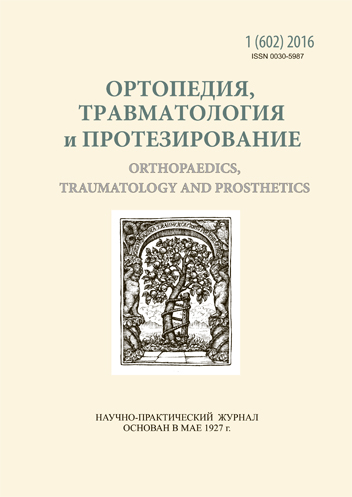The results of clinical application of the spring-loaded fixator in osteosynthesis of the medial fractures of femoral neck
DOI:
https://doi.org/10.15674/0030-59872016128-33Keywords:
osteosynthesis of femoral neck, spring-loaded device with ratchet gears, marginal resorption of fragmentsAbstract
The share of femoral neck fractures in the structure of injuries enlarges every year due to increasing number of elderly people. Known techniques of osteosynthesis do not provide satisfactory results of treatment in the majority of patients with medial femoral neck fractures.
The goal: to improve outcomes of treatment for the patients with medial femoral neck fractures through the development and introduction into clinical practice a new method of bone fragments connecting.
The methods: a new device for osteosynthesis of medial femoral neck fractures was worked out and implemented into clinical practice; due to its design features this device can provide primary intertrfragmental compression during surgery and secondary due to potential energy of the compressed spring. A special mechanism of ratchet gearing provides unidirectional telescopic effect and prevents the formation of interfragmental diastase that allow to achieve spontaneous fracture stabilization in postoperative period even with substantial edge resorption of fragments. 114 patients (aged from 23 to 92 years) underwent 115 ope-rations using proposed device from February 2011 to July 2015.
Results: positive results in the main clinical group, where proposed fixator was used, were obtained in 89 % cases.
Conclusions: the device, that was worked out, is substentiated from anatomical-clinical positions and concepts of resorptive process within the remodeling of bone fragments. The technique is highly effective osteosynthesis even under adverse prognostic for bone-healing of medial femoral neck fractures (II–III type by Pauwels, III–IV typeby Garden) in patients of different age groups. Minimally invasive surgery technique enables organ-savings surgery for elderly patients, including those with co-morbidities.References
- Gilfanov SI. Treatment of fractures of the proximal femur: abstract of the dis. the doctor of medical sciences. Moskow: J. GMA, 2010. 32 p.
- Loskutov AE. Hip arthroplasty. Dnepropetrovsk: Lira, 2010. 344 p.
- Loskutov AE, Degtjar AV. Endoprosthesis in patients with medial fractures of the femoral neck and their consequences [web source]. Trauma. 2011;12:3. Access mode: http://www.mif-ua.com/archive/article/23254.
- Pirogov EN. The method of treatment of medial femoral neck fractures and device for its implementation. Patent 98417 UА. 2011.
- Pirogov E. N. Evaluation of a boundary value resorption of bone fragments in the clinical application of a new lock for the fixation of the medial femoral neck fractures. Trauma. 2015;16(6):15–9.
- Pirogov EN, Tjazhelov AA. The role of the resorption phase of bone remodeling process in the development of nonunion after fixation of the medial fracture of the femoral neck (review). Orthopedics, traumatology and prosthetics. 2015;3:116–25. doi: 10.15674/0030-598720153116-125.
- Pliev DG. Predicting the results of osteosynthesis for fractures of the femoral neck: abstract of the dis. the candidate of medical sciences. 2009. 143 p.
- Pobel EA. Tense osteosynthesis for fractures of the proximal femur: abstract of the dis. the candidate of medical sciences. Kharkiv, 2007. 18 p.
- Tihilov RM, Karelkin VV, Kochish AJu, Kornilov BM. The results of the clinical use of a new method of fixation with bone unfree autoplasty with medial fractures of the femoral neck. Traumatology and orthopedics of Russia – Traumatologiya I ortopediya Rossii. 2013;(1):28–36.
- Shugol GB, Demakov SL, Shugol IG. Osteosynthesis of femoral neck fractures, based on the use of active fixation principle of contraction. Ekaterinburg: UGMU, 2014. 141 p.
- Shadko AA. Individual reconstructive approach to the treatment of patients with purulent arthritis of ankle joint [the web source]. Ukrainskii Khirurgicheskii Journal. 2013;1(20). Access mode: http://www.mif-ua.com/archive/article/35305.
Downloads
How to Cite
Issue
Section
License
Copyright (c) 2016 Evgeny Pirogov, Olexiy Tyazhelov

This work is licensed under a Creative Commons Attribution 4.0 International License.
The authors retain the right of authorship of their manuscript and pass the journal the right of the first publication of this article, which automatically become available from the date of publication under the terms of Creative Commons Attribution License, which allows others to freely distribute the published manuscript with mandatory linking to authors of the original research and the first publication of this one in this journal.
Authors have the right to enter into a separate supplemental agreement on the additional non-exclusive distribution of manuscript in the form in which it was published by the journal (i.e. to put work in electronic storage of an institution or publish as a part of the book) while maintaining the reference to the first publication of the manuscript in this journal.
The editorial policy of the journal allows authors and encourages manuscript accommodation online (i.e. in storage of an institution or on the personal websites) as before submission of the manuscript to the editorial office, and during its editorial processing because it contributes to productive scientific discussion and positively affects the efficiency and dynamics of the published manuscript citation (see The Effect of Open Access).














